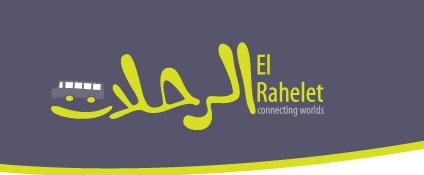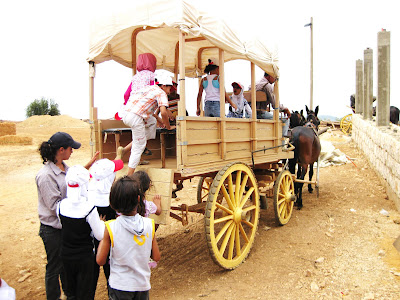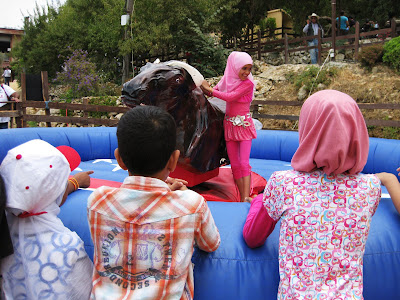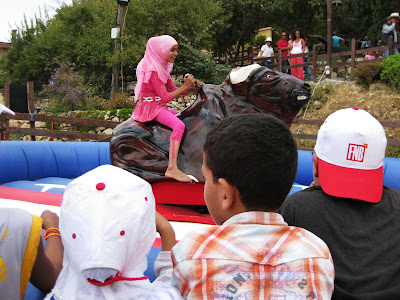Ain el Helwa camp
Sunday -July 26 - 2009
Sponsor: First National Bank
Facilitators: FNB, Lina, Nour, Melek
“Cowboys and Indians.” This is what El Rancho was all about - bringing the fun Western theme to the Middle East. There were hee-haws, lasoo swingers, plenty of hay bails, and sheriff’s badges. And it brought it all back for me too. As a child of course, whenever playing “Cowboys and Indians,” I’d always be a Cowboy. Never once as a kid had it ever crossed my mind to be an Indian. I was always a Cowboy. Cowboys were cool and “American.” The Indians were dark-skinned, seemed foreign (ironically enough), and couldn’t speak proper English. Who would ever want to be an “Indian?” Did any American boy in my neighborhood play the part of an Indian I wonder? We must have all have been Cowboys fighting against imaginary Indians – I don’t quite remember.
Waiting for the bathroom, I saw him, inspecting the statue of a Native American, or “Indian” as I knew it in my childhood. And then, though joking around, he stepped up and kissed the statue.
I felt something was powerful about that interaction, but couldn’t quite place a finger on it.
I had to re-confirm in my mind what I had just witnessed: a Palestinian refugee boy, showing intrigue and affection to a Native American statue. Now, I certainly don’t want to categorically compare the plight of the Palestinians to that of the Native Americans, but no one can deny how remarkably similar their histories are indeed.
I then started to wonder if the boy knew the history of the Native Americans, and if the kiss was something playful as I had originally suspected, or if it meant something more. Upon reflecting, I knew it just had to have been simply just a playful naïve kiss, given his age. But deep down, I wanted it to mean something more. I wanted him to understand what this statue represented and what that connection could mean for him. I wanted him to fully grasp the steadfastness and the importance of how this Native American was positioned. His arms were crossed, his chin up, with an intense look of respect and dignity on his face. It was a solid block of wood, as if not to budge even with the most ferocious weather or with even more persistent vandals. I wanted the boy to know, to share more with this carving, to inquire about it, to connect with it. Because though I understood its symbolism, this boy, at some point in his life, could fully empathize with it - something I would always be unable to truly do.
It didn’t take my mind long to then envision one such similar statue, but made of this Palestinian boy, arms folded in a similar fashion, with the same intense look, but made of a heavier wood, one even more steadfast and solid.
I kept thinking a bit more.
Where would, or where should this boy’s statue stand 50 years from now? On the ground of where his refugee camp was – if not still there then? Or back to his ancestors’ land in Palestine?
I also wondered what would be around it, and if another little boy would ever step up on a stoop to kiss his statue – and where that boy would be from, and if that boy would ever fully grasp what his statue symbolized.
Soon all the kids were finished with the bathroom stop, and we continued on to see some more of the animals. I reflected a bit more about my own childhood along the way.
Why was it that I was conditioned to always be a Cowboy as a child? And as an adolescent and into early adulthood, why was I always conditioned to think of Palestinians as the foe – such as the “Indians?” I felt a pounding of embarrassment and fury in my chest – knowing that I’d only realized the truth about the “Indians” after my childhood, and then the truth of the Palestinians, only a few years ago.
As we headed back to the bus at the end of our outing, we passed by the Native American statue again. He said something to me, I wasn’t sure what he whispered exactly, but it felt serious, and it felt nice. There was also a Cowboy statue on our way to the exit. And as I passed by it, I felt so much more differently about him, "The Cowboy," as I did as a kid. This statue didn’t say anything to me. And I didn’t have a good feeling about it. So, I continued to walk past him, with 20 of my most beloved kids … all mostly dark-skinned, “foreign,” and not able to speak proper English.
Monday, July 27, 2009
Subscribe to:
Post Comments (Atom)





































No comments:
Post a Comment